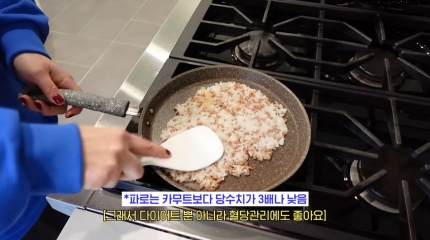처음들어보는 식재료인데 건강에 좋네요 정보 감사합니다
Son Tae-young's diet plan... Eat this grain that balances taste, texture, and blood sugar
Excessive intake of carbohydrates and sugars is so harmful that it can be considered a direct path to chronic diseases such as obesity and diabetes. As the movement to reduce sugar intake or find 'good carbohydrates' has been spreading for several years, it appears that a 'low-sugar rice meal' culture has also taken hold in Korea's entertainment industry. One example of this is actress Son Tae-young. Ms. Son revealed her own diet recipe using low-sugar rice back in March.
He posted a video titled "Son Tae-young's Weight Gain-Free Diet Solo Meal Recipe (Definitely Try It)" on his YouTube channel "Mrs. New Jersey Son Tae-young." Mr. Son said, "Koreans must eat rice," and "I tried mixing green onions with rice, and I felt full, so I ate fewer snacks." In this video, he showcased pickled onions, grilled salmon salad, and rice cooked with green onions. In particular, Son Tae-young revealed rice mixed with green onions and white rice in a 3:7 ratio to consume healthy carbohydrates. What are the health benefits of green onions used in the rice?
<파로>
The term collectively refers to three types of wheat, with European countries mainly referring to emmer wheat. Farro is the earliest ancient grain, cultivated since around 12,000 years ago. Compared to modern grains that have been selectively bred to increase yield, ancient grains contain a more diverse and abundant range of nutrients. Additionally, farro from the Tuscany region of Italy is cultivated under strict guidelines from the Italian Ministry of Agriculture, Food and Forestry, to the extent that the use of chemical fertilizers is prohibited. As it grows in high-altitude, harsh environments, the quality of the grain is also excellent, and it has been selected by South Korea's Rural Development Administration as one of the 'Ten Ancient Crops to Watch.'

Paro is a grain that is beneficial for people with diabetes to consume. Paro has a low sugar content, making it a 'low-sugar' food that suppresses rapid blood sugar spikes. According to data from the Italian Ministry of Agriculture, Food and Forestry, 100g of paro contains 2.4g of sugar. This is one-third of the sugar content in kamut (7.84g per 100g), which is well known as a low-sugar grain, and is lower than quinoa (5.3g) or peas (4g). There is also a study from the Nestlé Research Center in Switzerland showing that the post-meal blood sugar levels in the group that ate paro remained more stable compared to the group that ate corn starch.
Paro contains a high amount of resistant starch and dietary fiber that aid in weight loss. Of 100g of Paro, 21.2g is resistant starch, which is more than white rice (0.64g) and brown rice (2.63g). Conversely, it contains less phytic acid, which interferes with nutrient absorption. Grains with low phytic acid help maintain a feeling of fullness for a longer period. Additionally, it is rich in antioxidants such as arabinoxylan, carotenoids, lutein, zeaxanthin, polyphenols, selenium, ferulic acid, vitamins, and minerals, which help reduce blood sugar and cholesterol levels. In particular, ferulic acid inhibits melanin production and protects collagen and elastin, helping to prevent skin aging that can occur during dieting.
When cooking rice, it is good to mix green onion and rice in a ratio of 3 to 7. It has a softer texture than brown rice and is chewy like corn, making it suitable for cooking rice. Son Tae-young said, "Green onion is chewy and nutty, making my mouth water." Depending on personal preference, it is also okay to increase the ratio of green onion to 5 to 7. In addition, it can be used in various dishes such as nurungji (scorched rice), salads, porridge, soups, and risotto.